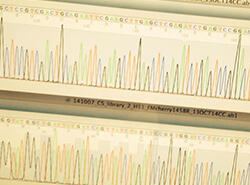
Martin R. Schiller, Executive Director of the Nevada Institute of Personalized Medicine
There are currently more than 12,000 known diseases, the majority containing some component of heritability. Why so many? Approximately 6,000 generations have lived since "Mitochondrial Eve," the matrilineal ancestor of all modern humans. Every new offspring throws an average of five new DNA variations, called variants, into the mix from 3.1 billion possible positions. These 6,000 generations of breeding have produced abundant variation, with about 4 million variants showing up in 1 percent of the population. If we count extremely rare variants, then approximately 100 million positions of our DNA are variable in the population. All this diversity means that we're all wired just a tad differently from one another.
Since Hippocrates introduced medicine in ancient Greece, its approach has been one size fits all, a practice formalized by today's HMOs. Another serious problem can be referred to as "skim-the-surface" medicine. With more than 12,000 diseases and even more diagnostic tests, even the most learned physician can know only a miniscule percentage of this vast knowledge domain, so trial-and-error medicine is employed. A front-line doctor evaluates symptoms, orders a standard set of diagnostic tests, and then refers the patient, if needed, to a specialist.
What do you think the odds are, using this approach, that your problem will be identified and fixed on the first attempt? If you've suffered more than a few medical setbacks, then you probably won't be surprised to read that, depending on the condition, they're only 30–50 percent. So additional tests are ordered — sometimes repeatedly — leading to costs that are expected to reach $5 trillion in the U.S. by the end of the decade.
There must be a better way!
Personalized Medicine
Personalized medicine, which recognizes that we are all wired differently, holds the greatest promise for transforming health care since antibiotics. The premise is that if specific DNA variants or sets of variants are highly correlated with a disease outcome, drug, or surgical intervention, then this information can be used to better predict disease and treatment outcomes. This is not future fantasy. Many genetic testing labs already conduct business using tests approved by the Food and Drug Administration, and 10 percent of the 1,117 FDA-approved drugs feature a DNA variant on their labels. This is already becoming a major industrial growth sector.

Imagine a future where a doctor collects a patient sample — perhaps spit, a cheek swab, or blood — and uses it to sequence all 3.1 billion bases of the patient's DNA. The DNA sequence is then analyzed and annotated through sophisticated software programs, resulting in easy-to-understand information that empowers patients to manage their health and well-being. People can make lifestyle and other personal decisions based on this information, such as the probability of developing a disease and when onset might occur. Instead of identifying and treating a disease after initial symptoms appear, individuals may work to prevent it. For example, once a woman shows symptoms of ovarian cancer, it is probably too late to cure. But if a gene analysis informs the patient of a 95 percent probability long before onset, she can have her ovaries removed, virtually eliminating the cancer risk, with enough time to freeze an ample amount of eggs for several courses of in vitro fertilization.
Reduced Costs
Shifting the emphasis of health care from reactive toward personalized strategic and preventive will also reduce health care costs. There are currently more than 18,000 diagnostic tests approved for use in the U.S., making it challenging, even for some experts, to know which to select for a specific patient. Based on vulnerabilities and probabilities identified by sequencing and analyzing patient DNA, a course of targeted screening will suggest testing for the diseases they are most likely to develop as they age, many of which can be prevented or delayed. This replaces unnecessary and costly diagnostic testing with a personalized and specific diagnostic screening regimen for diseases of concern.
A doctor will also be able to use DNA information from large groups of other patients with identical DNA variations, and known treatments and outcomes, to select the optimal therapy for each patient. Likewise, similar information can identify the best and worst drugs for each patient, including the optimal dosage of therapeutics, thereby maximizing results and reducing adverse reactions and side effects.

Once all patient genome and data is collected, it can be used by pharmaceutical and clinical trial organizations looking to improve patient outcomes. Analytics can be applied to the data to design new clinical trials for discovering new indications for disease, disease treatment and, ultimately, disease prevention. Another possibility, already emerging from a collaboration of the Schiller Laboratory of Applied Bioinformatics (Schiller LAB) with the Ruvo Center for Brain Health, is the repurposing of existing drugs based on analysis of patient DNA sequences.
Recognizing the importance of this problem and the promise of personalized medicine, UNLV has formed the Nevada Institute of Personalized Medicine (NIPM), and I am delighted to have the opportunity to lead this effort. We are carefully assembling a team of scientists who plan not only to perform cutting-edge research on specific aspects of personalized medicine but also to work toward implementing it in the health care system. We will be a key part in the national network of scientists and universities currently working on making personalized medicine a reality.
Our Future
Personalized medicine is generally not practiced in Nevada, but it is part of our nation's very near future. The Nevada Institute of Personalized Medicine will conduct research and clinical trials integrating genomics, computational biology, health informatics, and community health and outcomes research to drive personalized medicine. This will involve training and educating students as well as performing research and activities crucial to clinical patient care. It will lead to funded grants and, therefore, to private investment, jobs, and economic development in the health care sector. It will also work to help establish external commercial organizations to facilitate delivering personalized medicine to the local community.
This project has the potential to create an entire new industry in Nevada and become a foundational theme for the new Southern Nevada medical schools. There exists great potential for the creation of many new and high-paying jobs in this industry. It will also result in the immediate creation of jobs at local universities focused on research and educating a new workforce. Furthermore, health care savings, for both patient and provider, could help stimulate other spending and investment. Please take the time to explore our website to see what we have accomplished so far and how you can help.
— Martin Schiller